Report on Managing Food and Beverage Operations - HND Hospitality
VerifiedAdded on 2022/11/30
|13
|3564
|162
Report
AI Summary
This report delves into the intricacies of managing food and beverage operations, examining various aspects of the industry. It begins by exploring different types of businesses within the food and beverage sector, such as hotels and restaurants, and their respective advantages and disadvantages. The report then analyzes different rating systems used in the industry, highlighting their importance in assessing quality and customer satisfaction. Current and future trends, including plastic bans, health consciousness, and the impact of the COVID-19 pandemic, are discussed to provide insights into the evolving landscape of the industry. Furthermore, the report examines the professional skills required for food and beverage management, such as leadership, problem-solving, and communication. Legal requirements and regulatory standards are also addressed, emphasizing the importance of food safety and hygiene. The report compares different operational and marketing technologies used in food and beverage businesses and analyzes the factors influencing consumer decisions, including consumer behavior and strategies to attract customers. The report concludes with a comprehensive overview of the key findings and insights gained throughout the analysis.
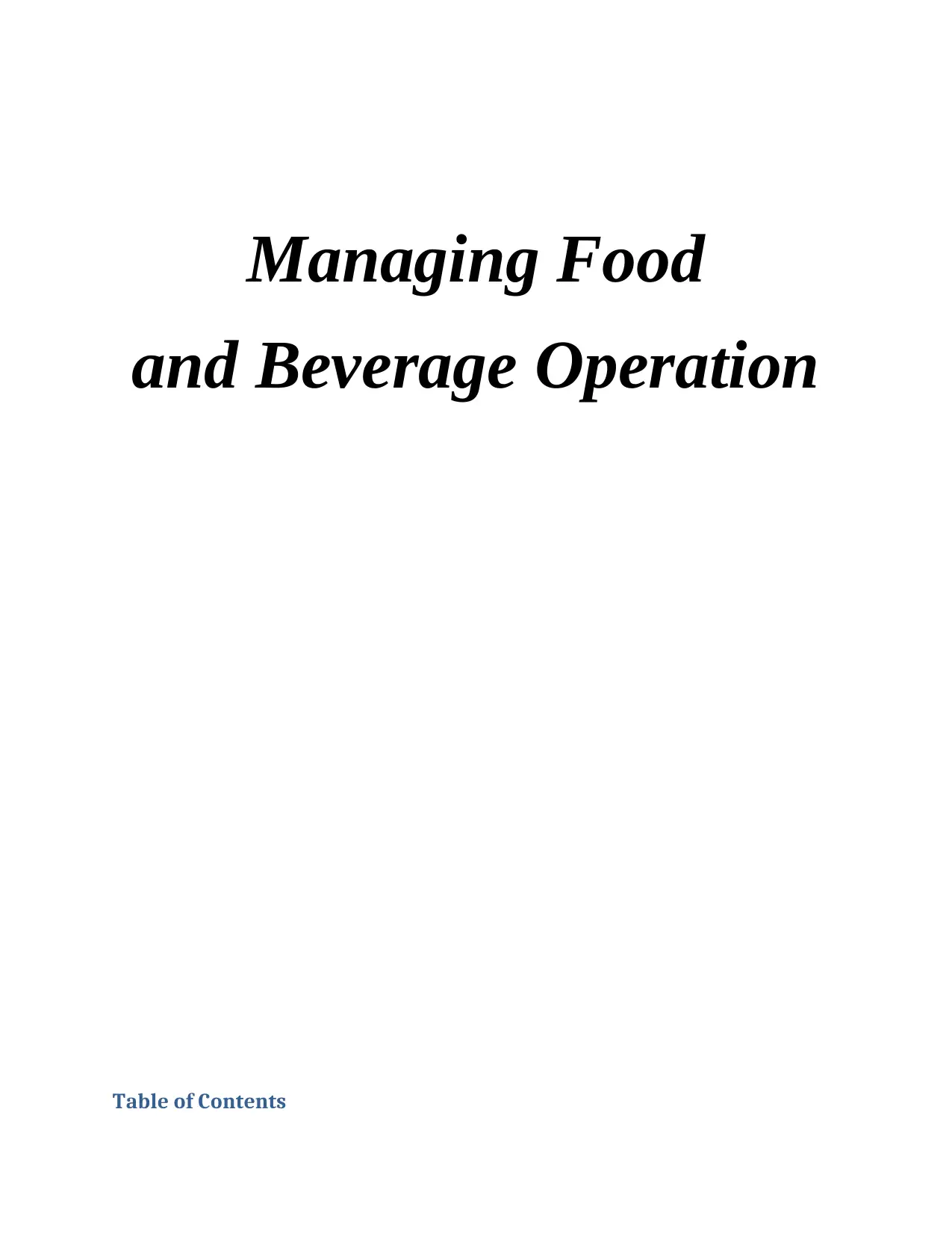
Managing Food
and Beverage Operation
Table of Contents
and Beverage Operation
Table of Contents
Paraphrase This Document
Need a fresh take? Get an instant paraphrase of this document with our AI Paraphraser
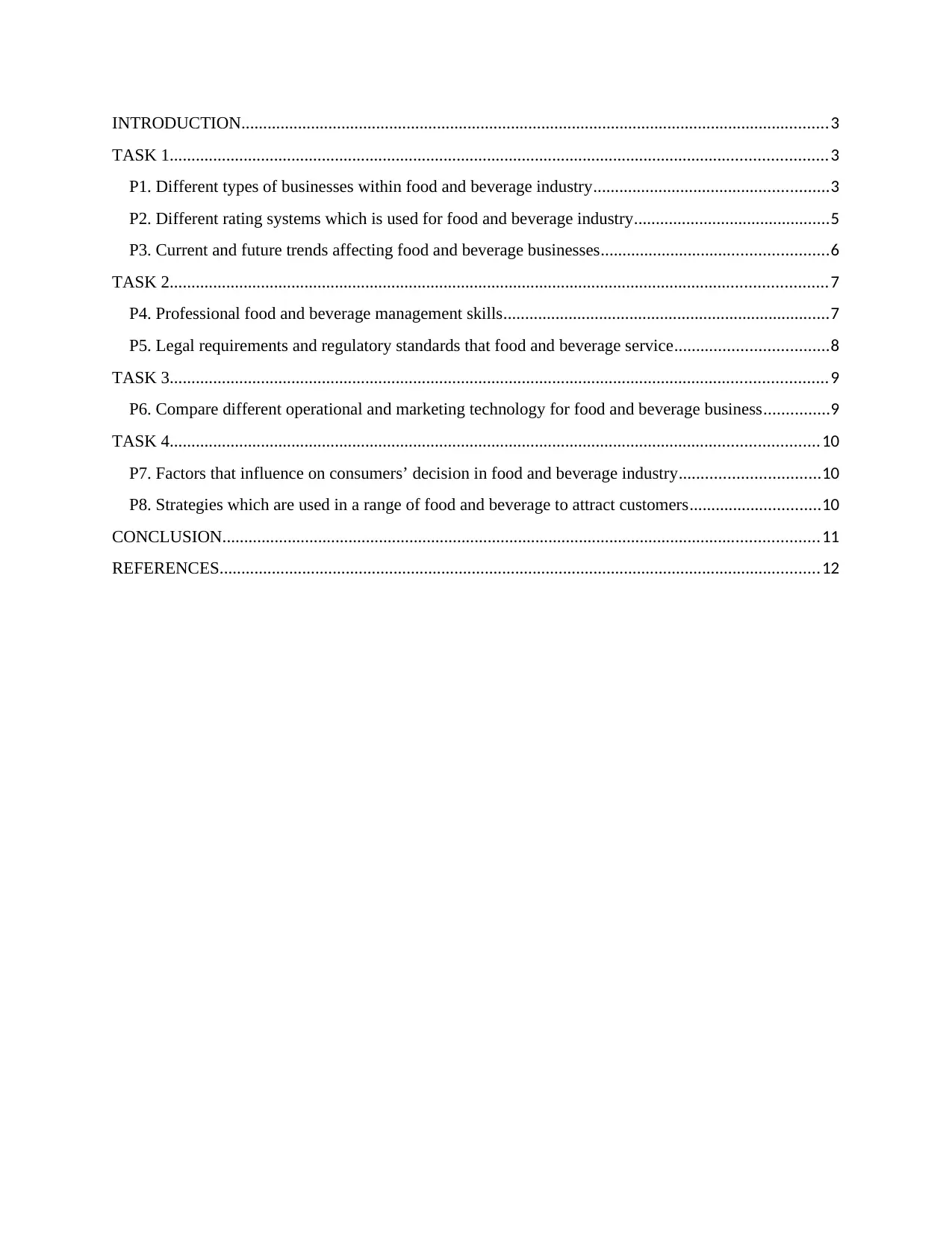
INTRODUCTION.......................................................................................................................................3
TASK 1.......................................................................................................................................................3
P1. Different types of businesses within food and beverage industry......................................................3
P2. Different rating systems which is used for food and beverage industry.............................................5
P3. Current and future trends affecting food and beverage businesses....................................................6
TASK 2.......................................................................................................................................................7
P4. Professional food and beverage management skills...........................................................................7
P5. Legal requirements and regulatory standards that food and beverage service...................................8
TASK 3.......................................................................................................................................................9
P6. Compare different operational and marketing technology for food and beverage business...............9
TASK 4.....................................................................................................................................................10
P7. Factors that influence on consumers’ decision in food and beverage industry................................10
P8. Strategies which are used in a range of food and beverage to attract customers..............................10
CONCLUSION.........................................................................................................................................11
REFERENCES..........................................................................................................................................12
TASK 1.......................................................................................................................................................3
P1. Different types of businesses within food and beverage industry......................................................3
P2. Different rating systems which is used for food and beverage industry.............................................5
P3. Current and future trends affecting food and beverage businesses....................................................6
TASK 2.......................................................................................................................................................7
P4. Professional food and beverage management skills...........................................................................7
P5. Legal requirements and regulatory standards that food and beverage service...................................8
TASK 3.......................................................................................................................................................9
P6. Compare different operational and marketing technology for food and beverage business...............9
TASK 4.....................................................................................................................................................10
P7. Factors that influence on consumers’ decision in food and beverage industry................................10
P8. Strategies which are used in a range of food and beverage to attract customers..............................10
CONCLUSION.........................................................................................................................................11
REFERENCES..........................................................................................................................................12
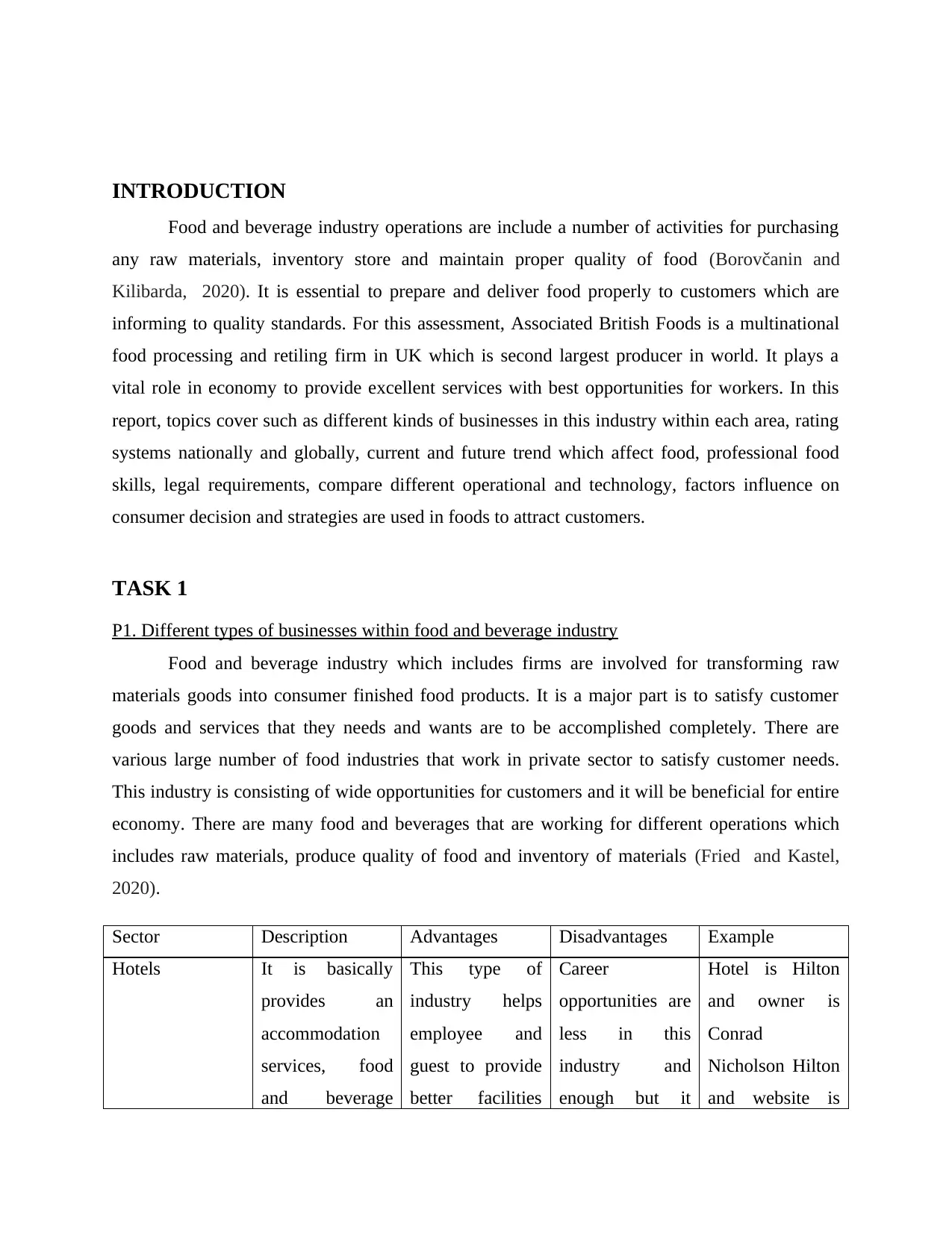
INTRODUCTION
Food and beverage industry operations are include a number of activities for purchasing
any raw materials, inventory store and maintain proper quality of food (Borovčanin and
Kilibarda, 2020). It is essential to prepare and deliver food properly to customers which are
informing to quality standards. For this assessment, Associated British Foods is a multinational
food processing and retiling firm in UK which is second largest producer in world. It plays a
vital role in economy to provide excellent services with best opportunities for workers. In this
report, topics cover such as different kinds of businesses in this industry within each area, rating
systems nationally and globally, current and future trend which affect food, professional food
skills, legal requirements, compare different operational and technology, factors influence on
consumer decision and strategies are used in foods to attract customers.
TASK 1
P1. Different types of businesses within food and beverage industry
Food and beverage industry which includes firms are involved for transforming raw
materials goods into consumer finished food products. It is a major part is to satisfy customer
goods and services that they needs and wants are to be accomplished completely. There are
various large number of food industries that work in private sector to satisfy customer needs.
This industry is consisting of wide opportunities for customers and it will be beneficial for entire
economy. There are many food and beverages that are working for different operations which
includes raw materials, produce quality of food and inventory of materials (Fried and Kastel,
2020).
Sector Description Advantages Disadvantages Example
Hotels It is basically
provides an
accommodation
services, food
and beverage
This type of
industry helps
employee and
guest to provide
better facilities
Career
opportunities are
less in this
industry and
enough but it
Hotel is Hilton
and owner is
Conrad
Nicholson Hilton
and website is
Food and beverage industry operations are include a number of activities for purchasing
any raw materials, inventory store and maintain proper quality of food (Borovčanin and
Kilibarda, 2020). It is essential to prepare and deliver food properly to customers which are
informing to quality standards. For this assessment, Associated British Foods is a multinational
food processing and retiling firm in UK which is second largest producer in world. It plays a
vital role in economy to provide excellent services with best opportunities for workers. In this
report, topics cover such as different kinds of businesses in this industry within each area, rating
systems nationally and globally, current and future trend which affect food, professional food
skills, legal requirements, compare different operational and technology, factors influence on
consumer decision and strategies are used in foods to attract customers.
TASK 1
P1. Different types of businesses within food and beverage industry
Food and beverage industry which includes firms are involved for transforming raw
materials goods into consumer finished food products. It is a major part is to satisfy customer
goods and services that they needs and wants are to be accomplished completely. There are
various large number of food industries that work in private sector to satisfy customer needs.
This industry is consisting of wide opportunities for customers and it will be beneficial for entire
economy. There are many food and beverages that are working for different operations which
includes raw materials, produce quality of food and inventory of materials (Fried and Kastel,
2020).
Sector Description Advantages Disadvantages Example
Hotels It is basically
provides an
accommodation
services, food
and beverage
This type of
industry helps
employee and
guest to provide
better facilities
Career
opportunities are
less in this
industry and
enough but it
Hotel is Hilton
and owner is
Conrad
Nicholson Hilton
and website is
⊘ This is a preview!⊘
Do you want full access?
Subscribe today to unlock all pages.

Trusted by 1+ million students worldwide
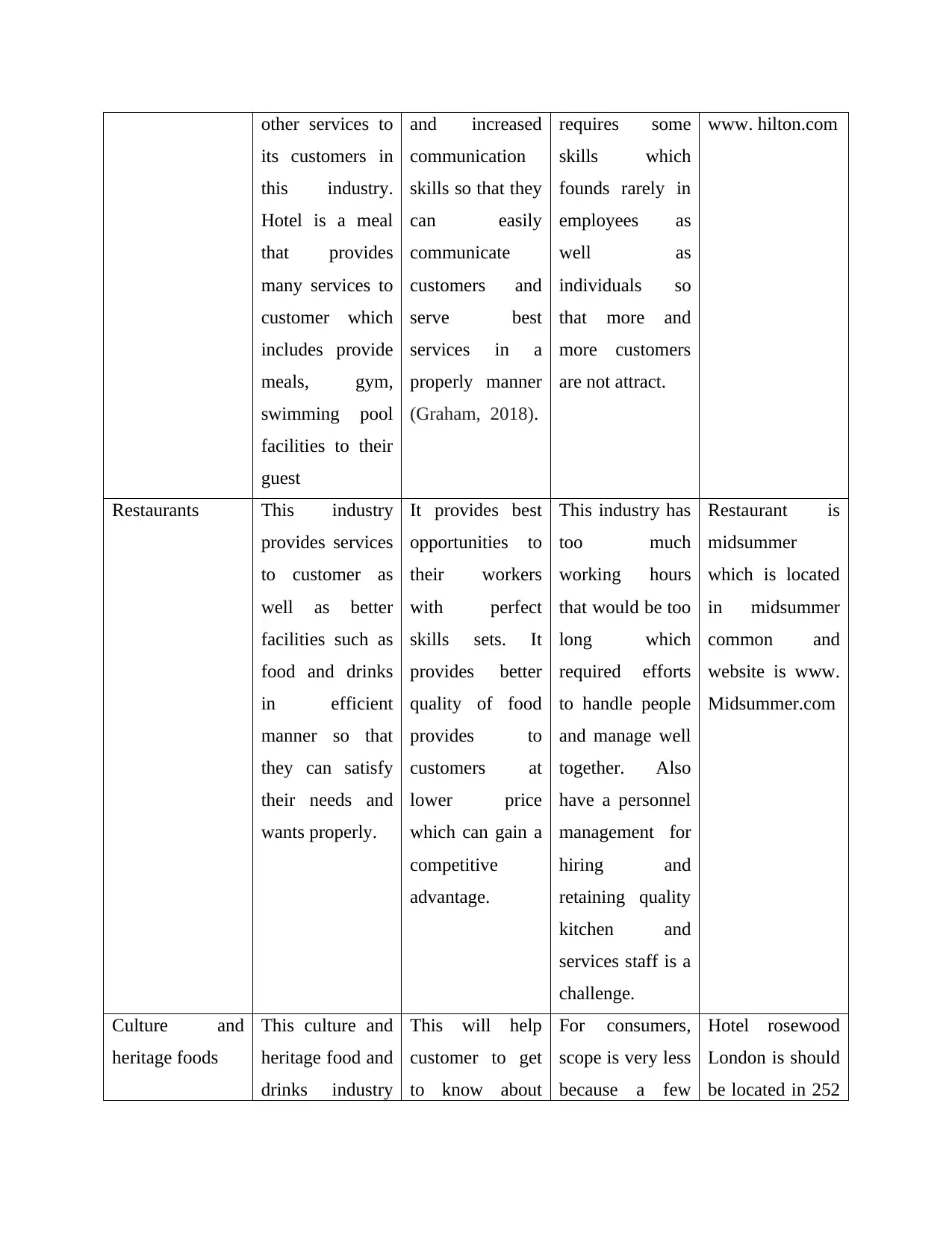
other services to
its customers in
this industry.
Hotel is a meal
that provides
many services to
customer which
includes provide
meals, gym,
swimming pool
facilities to their
guest
and increased
communication
skills so that they
can easily
communicate
customers and
serve best
services in a
properly manner
(Graham, 2018).
requires some
skills which
founds rarely in
employees as
well as
individuals so
that more and
more customers
are not attract.
www. hilton.com
Restaurants This industry
provides services
to customer as
well as better
facilities such as
food and drinks
in efficient
manner so that
they can satisfy
their needs and
wants properly.
It provides best
opportunities to
their workers
with perfect
skills sets. It
provides better
quality of food
provides to
customers at
lower price
which can gain a
competitive
advantage.
This industry has
too much
working hours
that would be too
long which
required efforts
to handle people
and manage well
together. Also
have a personnel
management for
hiring and
retaining quality
kitchen and
services staff is a
challenge.
Restaurant is
midsummer
which is located
in midsummer
common and
website is www.
Midsummer.com
Culture and
heritage foods
This culture and
heritage food and
drinks industry
This will help
customer to get
to know about
For consumers,
scope is very less
because a few
Hotel rosewood
London is should
be located in 252
its customers in
this industry.
Hotel is a meal
that provides
many services to
customer which
includes provide
meals, gym,
swimming pool
facilities to their
guest
and increased
communication
skills so that they
can easily
communicate
customers and
serve best
services in a
properly manner
(Graham, 2018).
requires some
skills which
founds rarely in
employees as
well as
individuals so
that more and
more customers
are not attract.
www. hilton.com
Restaurants This industry
provides services
to customer as
well as better
facilities such as
food and drinks
in efficient
manner so that
they can satisfy
their needs and
wants properly.
It provides best
opportunities to
their workers
with perfect
skills sets. It
provides better
quality of food
provides to
customers at
lower price
which can gain a
competitive
advantage.
This industry has
too much
working hours
that would be too
long which
required efforts
to handle people
and manage well
together. Also
have a personnel
management for
hiring and
retaining quality
kitchen and
services staff is a
challenge.
Restaurant is
midsummer
which is located
in midsummer
common and
website is www.
Midsummer.com
Culture and
heritage foods
This culture and
heritage food and
drinks industry
This will help
customer to get
to know about
For consumers,
scope is very less
because a few
Hotel rosewood
London is should
be located in 252
Paraphrase This Document
Need a fresh take? Get an instant paraphrase of this document with our AI Paraphraser
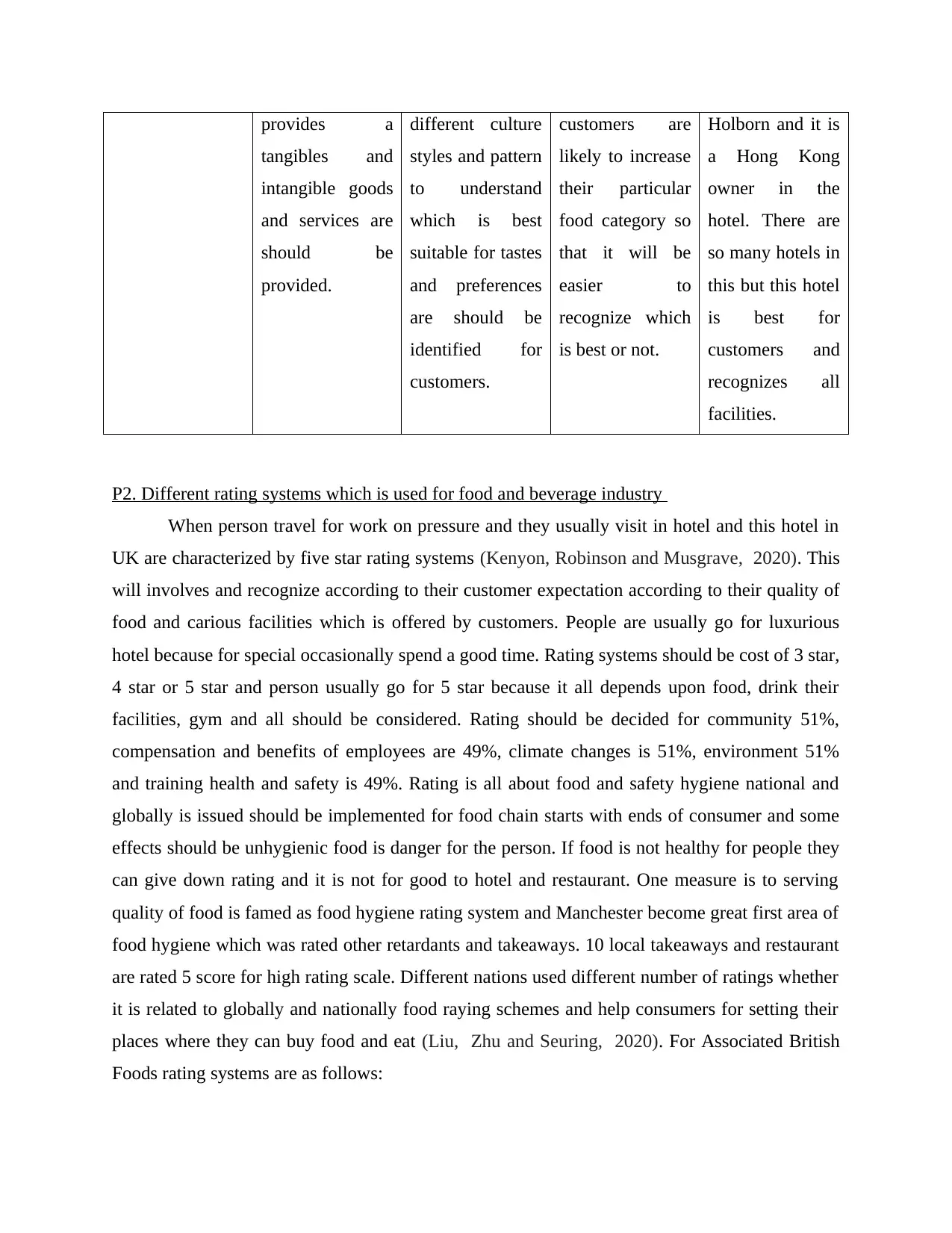
provides a
tangibles and
intangible goods
and services are
should be
provided.
different culture
styles and pattern
to understand
which is best
suitable for tastes
and preferences
are should be
identified for
customers.
customers are
likely to increase
their particular
food category so
that it will be
easier to
recognize which
is best or not.
Holborn and it is
a Hong Kong
owner in the
hotel. There are
so many hotels in
this but this hotel
is best for
customers and
recognizes all
facilities.
P2. Different rating systems which is used for food and beverage industry
When person travel for work on pressure and they usually visit in hotel and this hotel in
UK are characterized by five star rating systems (Kenyon, Robinson and Musgrave, 2020). This
will involves and recognize according to their customer expectation according to their quality of
food and carious facilities which is offered by customers. People are usually go for luxurious
hotel because for special occasionally spend a good time. Rating systems should be cost of 3 star,
4 star or 5 star and person usually go for 5 star because it all depends upon food, drink their
facilities, gym and all should be considered. Rating should be decided for community 51%,
compensation and benefits of employees are 49%, climate changes is 51%, environment 51%
and training health and safety is 49%. Rating is all about food and safety hygiene national and
globally is issued should be implemented for food chain starts with ends of consumer and some
effects should be unhygienic food is danger for the person. If food is not healthy for people they
can give down rating and it is not for good to hotel and restaurant. One measure is to serving
quality of food is famed as food hygiene rating system and Manchester become great first area of
food hygiene which was rated other retardants and takeaways. 10 local takeaways and restaurant
are rated 5 score for high rating scale. Different nations used different number of ratings whether
it is related to globally and nationally food raying schemes and help consumers for setting their
places where they can buy food and eat (Liu, Zhu and Seuring, 2020). For Associated British
Foods rating systems are as follows:
tangibles and
intangible goods
and services are
should be
provided.
different culture
styles and pattern
to understand
which is best
suitable for tastes
and preferences
are should be
identified for
customers.
customers are
likely to increase
their particular
food category so
that it will be
easier to
recognize which
is best or not.
Holborn and it is
a Hong Kong
owner in the
hotel. There are
so many hotels in
this but this hotel
is best for
customers and
recognizes all
facilities.
P2. Different rating systems which is used for food and beverage industry
When person travel for work on pressure and they usually visit in hotel and this hotel in
UK are characterized by five star rating systems (Kenyon, Robinson and Musgrave, 2020). This
will involves and recognize according to their customer expectation according to their quality of
food and carious facilities which is offered by customers. People are usually go for luxurious
hotel because for special occasionally spend a good time. Rating systems should be cost of 3 star,
4 star or 5 star and person usually go for 5 star because it all depends upon food, drink their
facilities, gym and all should be considered. Rating should be decided for community 51%,
compensation and benefits of employees are 49%, climate changes is 51%, environment 51%
and training health and safety is 49%. Rating is all about food and safety hygiene national and
globally is issued should be implemented for food chain starts with ends of consumer and some
effects should be unhygienic food is danger for the person. If food is not healthy for people they
can give down rating and it is not for good to hotel and restaurant. One measure is to serving
quality of food is famed as food hygiene rating system and Manchester become great first area of
food hygiene which was rated other retardants and takeaways. 10 local takeaways and restaurant
are rated 5 score for high rating scale. Different nations used different number of ratings whether
it is related to globally and nationally food raying schemes and help consumers for setting their
places where they can buy food and eat (Liu, Zhu and Seuring, 2020). For Associated British
Foods rating systems are as follows:
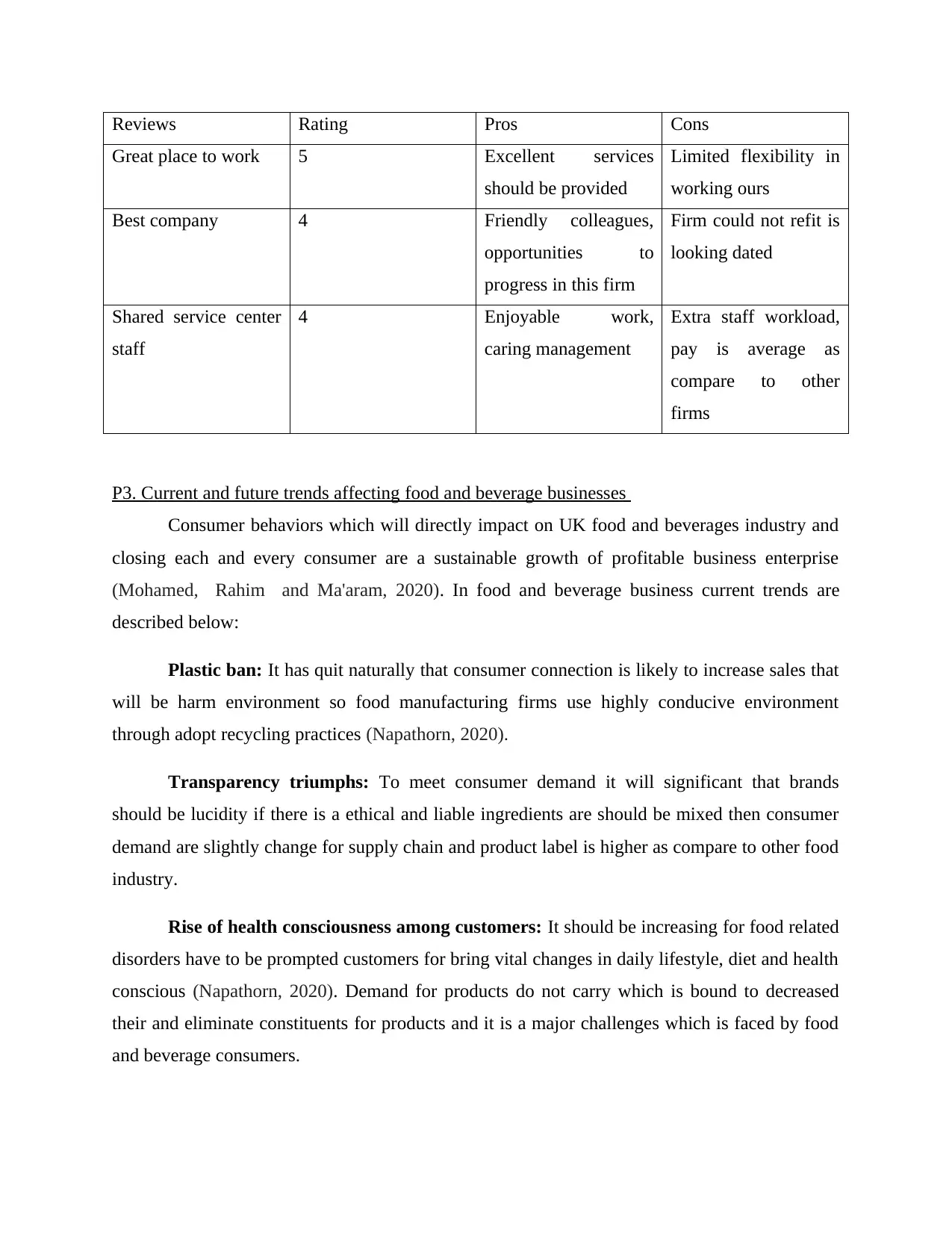
Reviews Rating Pros Cons
Great place to work 5 Excellent services
should be provided
Limited flexibility in
working ours
Best company 4 Friendly colleagues,
opportunities to
progress in this firm
Firm could not refit is
looking dated
Shared service center
staff
4 Enjoyable work,
caring management
Extra staff workload,
pay is average as
compare to other
firms
P3. Current and future trends affecting food and beverage businesses
Consumer behaviors which will directly impact on UK food and beverages industry and
closing each and every consumer are a sustainable growth of profitable business enterprise
(Mohamed, Rahim and Ma'aram, 2020). In food and beverage business current trends are
described below:
Plastic ban: It has quit naturally that consumer connection is likely to increase sales that
will be harm environment so food manufacturing firms use highly conducive environment
through adopt recycling practices (Napathorn, 2020).
Transparency triumphs: To meet consumer demand it will significant that brands
should be lucidity if there is a ethical and liable ingredients are should be mixed then consumer
demand are slightly change for supply chain and product label is higher as compare to other food
industry.
Rise of health consciousness among customers: It should be increasing for food related
disorders have to be prompted customers for bring vital changes in daily lifestyle, diet and health
conscious (Napathorn, 2020). Demand for products do not carry which is bound to decreased
their and eliminate constituents for products and it is a major challenges which is faced by food
and beverage consumers.
Great place to work 5 Excellent services
should be provided
Limited flexibility in
working ours
Best company 4 Friendly colleagues,
opportunities to
progress in this firm
Firm could not refit is
looking dated
Shared service center
staff
4 Enjoyable work,
caring management
Extra staff workload,
pay is average as
compare to other
firms
P3. Current and future trends affecting food and beverage businesses
Consumer behaviors which will directly impact on UK food and beverages industry and
closing each and every consumer are a sustainable growth of profitable business enterprise
(Mohamed, Rahim and Ma'aram, 2020). In food and beverage business current trends are
described below:
Plastic ban: It has quit naturally that consumer connection is likely to increase sales that
will be harm environment so food manufacturing firms use highly conducive environment
through adopt recycling practices (Napathorn, 2020).
Transparency triumphs: To meet consumer demand it will significant that brands
should be lucidity if there is a ethical and liable ingredients are should be mixed then consumer
demand are slightly change for supply chain and product label is higher as compare to other food
industry.
Rise of health consciousness among customers: It should be increasing for food related
disorders have to be prompted customers for bring vital changes in daily lifestyle, diet and health
conscious (Napathorn, 2020). Demand for products do not carry which is bound to decreased
their and eliminate constituents for products and it is a major challenges which is faced by food
and beverage consumers.
⊘ This is a preview!⊘
Do you want full access?
Subscribe today to unlock all pages.

Trusted by 1+ million students worldwide
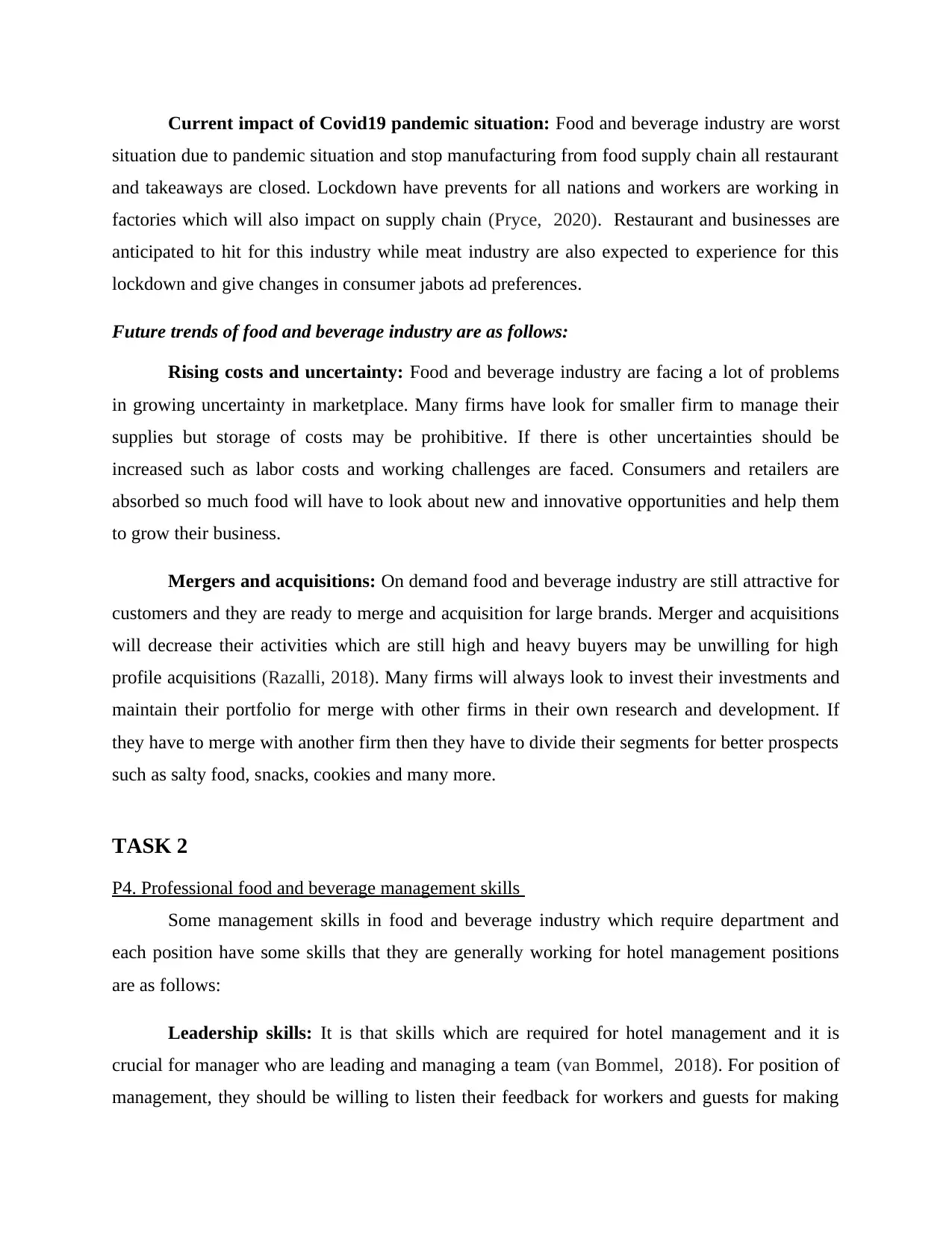
Current impact of Covid19 pandemic situation: Food and beverage industry are worst
situation due to pandemic situation and stop manufacturing from food supply chain all restaurant
and takeaways are closed. Lockdown have prevents for all nations and workers are working in
factories which will also impact on supply chain (Pryce, 2020). Restaurant and businesses are
anticipated to hit for this industry while meat industry are also expected to experience for this
lockdown and give changes in consumer jabots ad preferences.
Future trends of food and beverage industry are as follows:
Rising costs and uncertainty: Food and beverage industry are facing a lot of problems
in growing uncertainty in marketplace. Many firms have look for smaller firm to manage their
supplies but storage of costs may be prohibitive. If there is other uncertainties should be
increased such as labor costs and working challenges are faced. Consumers and retailers are
absorbed so much food will have to look about new and innovative opportunities and help them
to grow their business.
Mergers and acquisitions: On demand food and beverage industry are still attractive for
customers and they are ready to merge and acquisition for large brands. Merger and acquisitions
will decrease their activities which are still high and heavy buyers may be unwilling for high
profile acquisitions (Razalli, 2018). Many firms will always look to invest their investments and
maintain their portfolio for merge with other firms in their own research and development. If
they have to merge with another firm then they have to divide their segments for better prospects
such as salty food, snacks, cookies and many more.
TASK 2
P4. Professional food and beverage management skills
Some management skills in food and beverage industry which require department and
each position have some skills that they are generally working for hotel management positions
are as follows:
Leadership skills: It is that skills which are required for hotel management and it is
crucial for manager who are leading and managing a team (van Bommel, 2018). For position of
management, they should be willing to listen their feedback for workers and guests for making
situation due to pandemic situation and stop manufacturing from food supply chain all restaurant
and takeaways are closed. Lockdown have prevents for all nations and workers are working in
factories which will also impact on supply chain (Pryce, 2020). Restaurant and businesses are
anticipated to hit for this industry while meat industry are also expected to experience for this
lockdown and give changes in consumer jabots ad preferences.
Future trends of food and beverage industry are as follows:
Rising costs and uncertainty: Food and beverage industry are facing a lot of problems
in growing uncertainty in marketplace. Many firms have look for smaller firm to manage their
supplies but storage of costs may be prohibitive. If there is other uncertainties should be
increased such as labor costs and working challenges are faced. Consumers and retailers are
absorbed so much food will have to look about new and innovative opportunities and help them
to grow their business.
Mergers and acquisitions: On demand food and beverage industry are still attractive for
customers and they are ready to merge and acquisition for large brands. Merger and acquisitions
will decrease their activities which are still high and heavy buyers may be unwilling for high
profile acquisitions (Razalli, 2018). Many firms will always look to invest their investments and
maintain their portfolio for merge with other firms in their own research and development. If
they have to merge with another firm then they have to divide their segments for better prospects
such as salty food, snacks, cookies and many more.
TASK 2
P4. Professional food and beverage management skills
Some management skills in food and beverage industry which require department and
each position have some skills that they are generally working for hotel management positions
are as follows:
Leadership skills: It is that skills which are required for hotel management and it is
crucial for manager who are leading and managing a team (van Bommel, 2018). For position of
management, they should be willing to listen their feedback for workers and guests for making
Paraphrase This Document
Need a fresh take? Get an instant paraphrase of this document with our AI Paraphraser
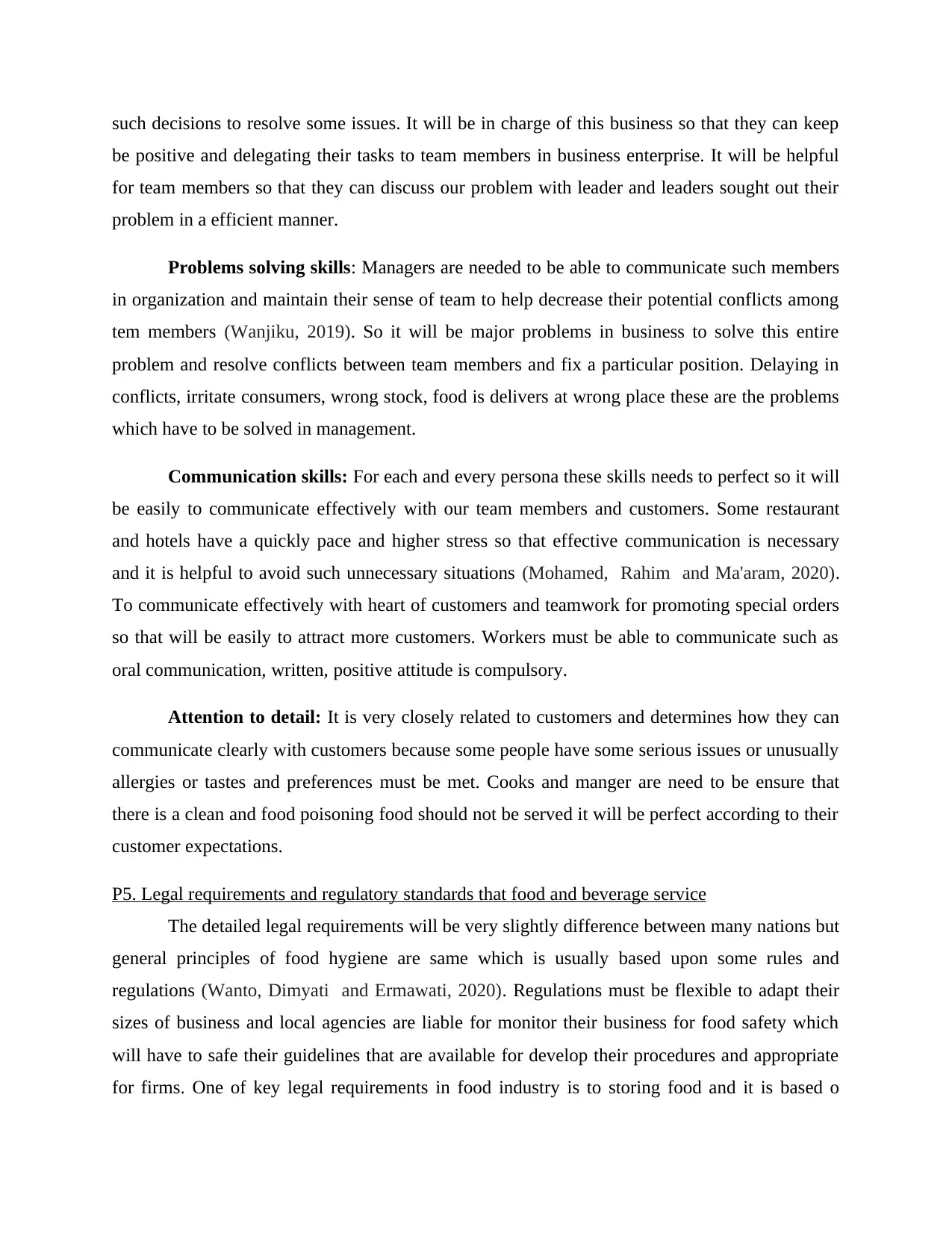
such decisions to resolve some issues. It will be in charge of this business so that they can keep
be positive and delegating their tasks to team members in business enterprise. It will be helpful
for team members so that they can discuss our problem with leader and leaders sought out their
problem in a efficient manner.
Problems solving skills: Managers are needed to be able to communicate such members
in organization and maintain their sense of team to help decrease their potential conflicts among
tem members (Wanjiku, 2019). So it will be major problems in business to solve this entire
problem and resolve conflicts between team members and fix a particular position. Delaying in
conflicts, irritate consumers, wrong stock, food is delivers at wrong place these are the problems
which have to be solved in management.
Communication skills: For each and every persona these skills needs to perfect so it will
be easily to communicate effectively with our team members and customers. Some restaurant
and hotels have a quickly pace and higher stress so that effective communication is necessary
and it is helpful to avoid such unnecessary situations (Mohamed, Rahim and Ma'aram, 2020).
To communicate effectively with heart of customers and teamwork for promoting special orders
so that will be easily to attract more customers. Workers must be able to communicate such as
oral communication, written, positive attitude is compulsory.
Attention to detail: It is very closely related to customers and determines how they can
communicate clearly with customers because some people have some serious issues or unusually
allergies or tastes and preferences must be met. Cooks and manger are need to be ensure that
there is a clean and food poisoning food should not be served it will be perfect according to their
customer expectations.
P5. Legal requirements and regulatory standards that food and beverage service
The detailed legal requirements will be very slightly difference between many nations but
general principles of food hygiene are same which is usually based upon some rules and
regulations (Wanto, Dimyati and Ermawati, 2020). Regulations must be flexible to adapt their
sizes of business and local agencies are liable for monitor their business for food safety which
will have to safe their guidelines that are available for develop their procedures and appropriate
for firms. One of key legal requirements in food industry is to storing food and it is based o
be positive and delegating their tasks to team members in business enterprise. It will be helpful
for team members so that they can discuss our problem with leader and leaders sought out their
problem in a efficient manner.
Problems solving skills: Managers are needed to be able to communicate such members
in organization and maintain their sense of team to help decrease their potential conflicts among
tem members (Wanjiku, 2019). So it will be major problems in business to solve this entire
problem and resolve conflicts between team members and fix a particular position. Delaying in
conflicts, irritate consumers, wrong stock, food is delivers at wrong place these are the problems
which have to be solved in management.
Communication skills: For each and every persona these skills needs to perfect so it will
be easily to communicate effectively with our team members and customers. Some restaurant
and hotels have a quickly pace and higher stress so that effective communication is necessary
and it is helpful to avoid such unnecessary situations (Mohamed, Rahim and Ma'aram, 2020).
To communicate effectively with heart of customers and teamwork for promoting special orders
so that will be easily to attract more customers. Workers must be able to communicate such as
oral communication, written, positive attitude is compulsory.
Attention to detail: It is very closely related to customers and determines how they can
communicate clearly with customers because some people have some serious issues or unusually
allergies or tastes and preferences must be met. Cooks and manger are need to be ensure that
there is a clean and food poisoning food should not be served it will be perfect according to their
customer expectations.
P5. Legal requirements and regulatory standards that food and beverage service
The detailed legal requirements will be very slightly difference between many nations but
general principles of food hygiene are same which is usually based upon some rules and
regulations (Wanto, Dimyati and Ermawati, 2020). Regulations must be flexible to adapt their
sizes of business and local agencies are liable for monitor their business for food safety which
will have to safe their guidelines that are available for develop their procedures and appropriate
for firms. One of key legal requirements in food industry is to storing food and it is based o
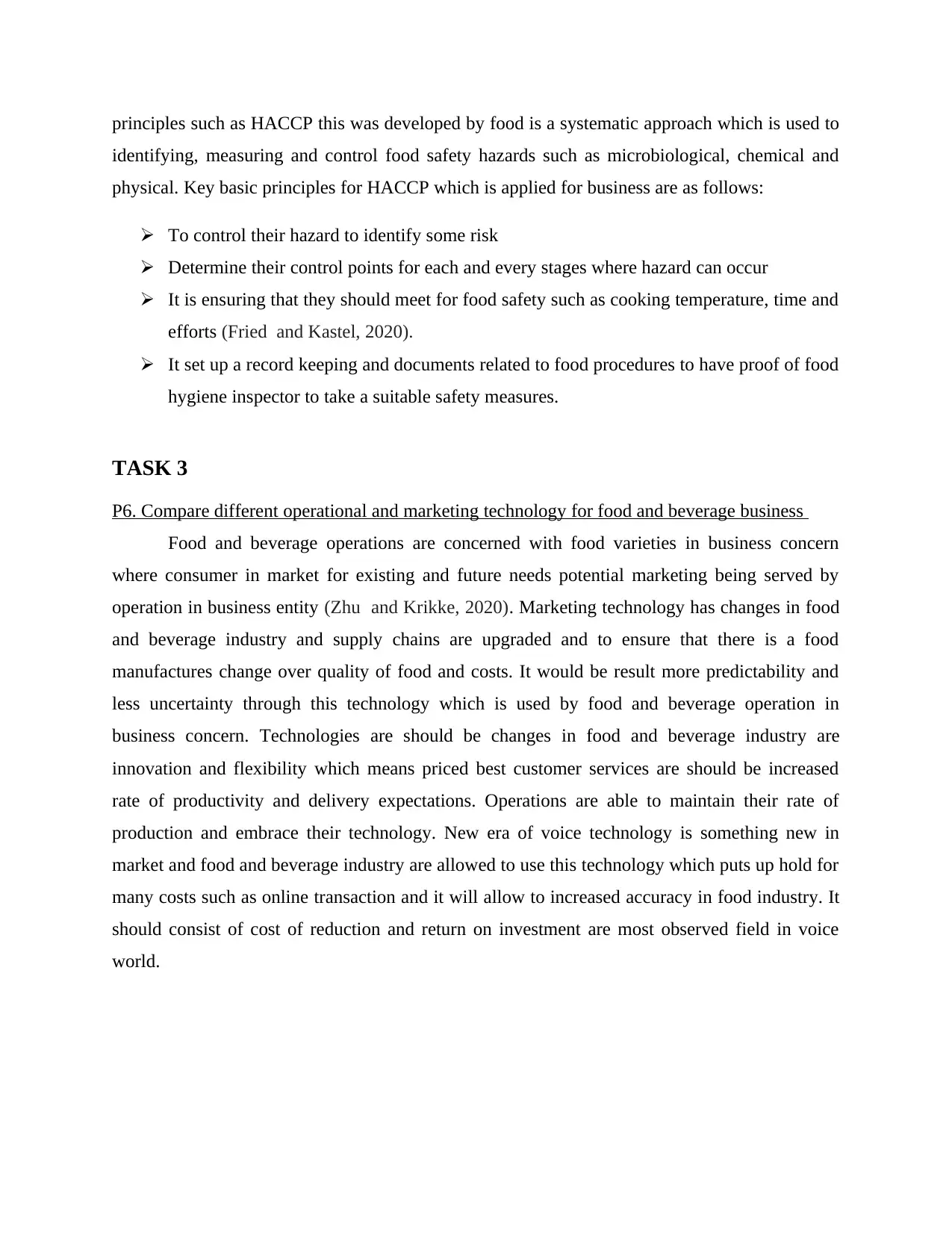
principles such as HACCP this was developed by food is a systematic approach which is used to
identifying, measuring and control food safety hazards such as microbiological, chemical and
physical. Key basic principles for HACCP which is applied for business are as follows:
To control their hazard to identify some risk
Determine their control points for each and every stages where hazard can occur
It is ensuring that they should meet for food safety such as cooking temperature, time and
efforts (Fried and Kastel, 2020).
It set up a record keeping and documents related to food procedures to have proof of food
hygiene inspector to take a suitable safety measures.
TASK 3
P6. Compare different operational and marketing technology for food and beverage business
Food and beverage operations are concerned with food varieties in business concern
where consumer in market for existing and future needs potential marketing being served by
operation in business entity (Zhu and Krikke, 2020). Marketing technology has changes in food
and beverage industry and supply chains are upgraded and to ensure that there is a food
manufactures change over quality of food and costs. It would be result more predictability and
less uncertainty through this technology which is used by food and beverage operation in
business concern. Technologies are should be changes in food and beverage industry are
innovation and flexibility which means priced best customer services are should be increased
rate of productivity and delivery expectations. Operations are able to maintain their rate of
production and embrace their technology. New era of voice technology is something new in
market and food and beverage industry are allowed to use this technology which puts up hold for
many costs such as online transaction and it will allow to increased accuracy in food industry. It
should consist of cost of reduction and return on investment are most observed field in voice
world.
identifying, measuring and control food safety hazards such as microbiological, chemical and
physical. Key basic principles for HACCP which is applied for business are as follows:
To control their hazard to identify some risk
Determine their control points for each and every stages where hazard can occur
It is ensuring that they should meet for food safety such as cooking temperature, time and
efforts (Fried and Kastel, 2020).
It set up a record keeping and documents related to food procedures to have proof of food
hygiene inspector to take a suitable safety measures.
TASK 3
P6. Compare different operational and marketing technology for food and beverage business
Food and beverage operations are concerned with food varieties in business concern
where consumer in market for existing and future needs potential marketing being served by
operation in business entity (Zhu and Krikke, 2020). Marketing technology has changes in food
and beverage industry and supply chains are upgraded and to ensure that there is a food
manufactures change over quality of food and costs. It would be result more predictability and
less uncertainty through this technology which is used by food and beverage operation in
business concern. Technologies are should be changes in food and beverage industry are
innovation and flexibility which means priced best customer services are should be increased
rate of productivity and delivery expectations. Operations are able to maintain their rate of
production and embrace their technology. New era of voice technology is something new in
market and food and beverage industry are allowed to use this technology which puts up hold for
many costs such as online transaction and it will allow to increased accuracy in food industry. It
should consist of cost of reduction and return on investment are most observed field in voice
world.
⊘ This is a preview!⊘
Do you want full access?
Subscribe today to unlock all pages.

Trusted by 1+ million students worldwide
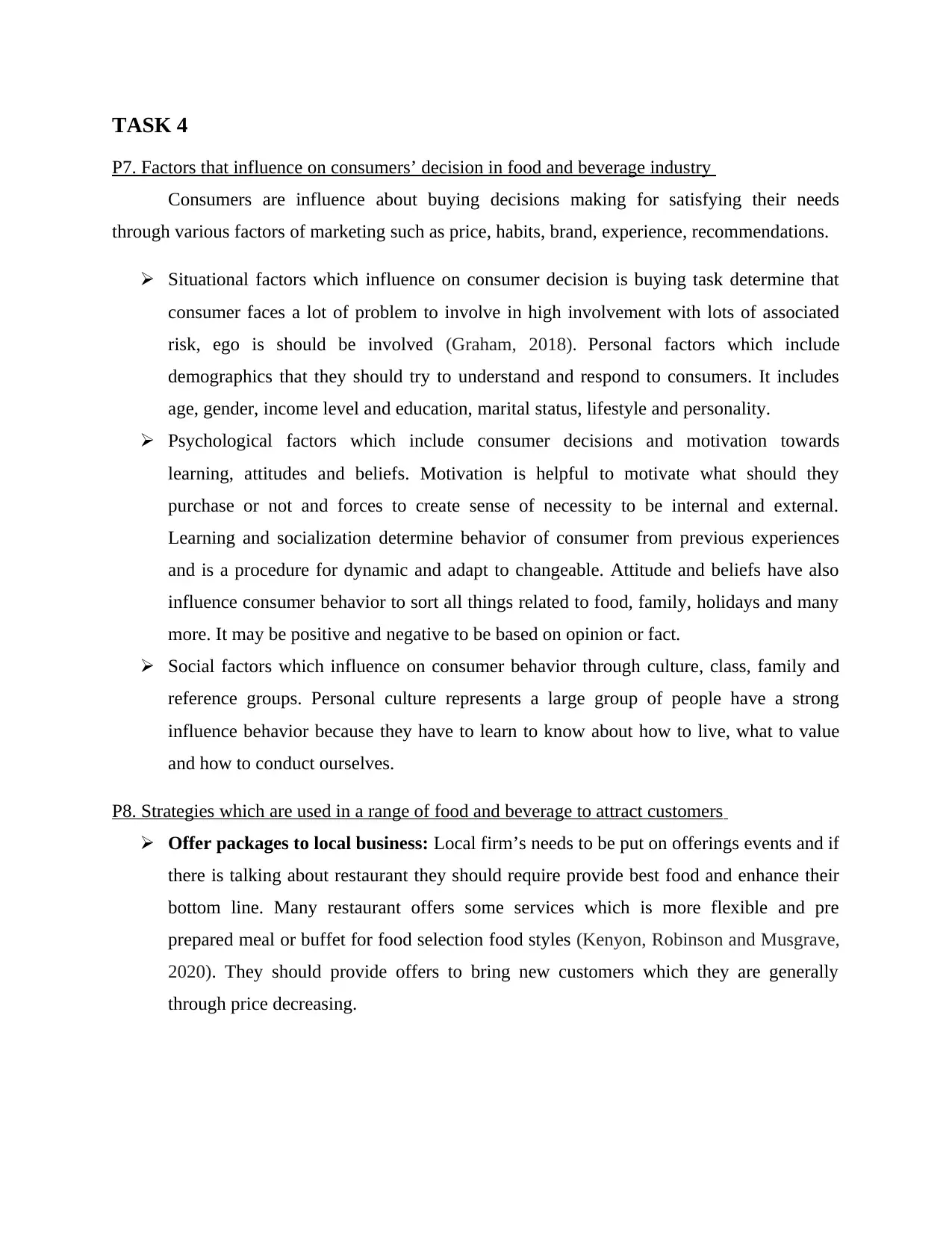
TASK 4
P7. Factors that influence on consumers’ decision in food and beverage industry
Consumers are influence about buying decisions making for satisfying their needs
through various factors of marketing such as price, habits, brand, experience, recommendations.
Situational factors which influence on consumer decision is buying task determine that
consumer faces a lot of problem to involve in high involvement with lots of associated
risk, ego is should be involved (Graham, 2018). Personal factors which include
demographics that they should try to understand and respond to consumers. It includes
age, gender, income level and education, marital status, lifestyle and personality.
Psychological factors which include consumer decisions and motivation towards
learning, attitudes and beliefs. Motivation is helpful to motivate what should they
purchase or not and forces to create sense of necessity to be internal and external.
Learning and socialization determine behavior of consumer from previous experiences
and is a procedure for dynamic and adapt to changeable. Attitude and beliefs have also
influence consumer behavior to sort all things related to food, family, holidays and many
more. It may be positive and negative to be based on opinion or fact.
Social factors which influence on consumer behavior through culture, class, family and
reference groups. Personal culture represents a large group of people have a strong
influence behavior because they have to learn to know about how to live, what to value
and how to conduct ourselves.
P8. Strategies which are used in a range of food and beverage to attract customers
Offer packages to local business: Local firm’s needs to be put on offerings events and if
there is talking about restaurant they should require provide best food and enhance their
bottom line. Many restaurant offers some services which is more flexible and pre
prepared meal or buffet for food selection food styles (Kenyon, Robinson and Musgrave,
2020). They should provide offers to bring new customers which they are generally
through price decreasing.
P7. Factors that influence on consumers’ decision in food and beverage industry
Consumers are influence about buying decisions making for satisfying their needs
through various factors of marketing such as price, habits, brand, experience, recommendations.
Situational factors which influence on consumer decision is buying task determine that
consumer faces a lot of problem to involve in high involvement with lots of associated
risk, ego is should be involved (Graham, 2018). Personal factors which include
demographics that they should try to understand and respond to consumers. It includes
age, gender, income level and education, marital status, lifestyle and personality.
Psychological factors which include consumer decisions and motivation towards
learning, attitudes and beliefs. Motivation is helpful to motivate what should they
purchase or not and forces to create sense of necessity to be internal and external.
Learning and socialization determine behavior of consumer from previous experiences
and is a procedure for dynamic and adapt to changeable. Attitude and beliefs have also
influence consumer behavior to sort all things related to food, family, holidays and many
more. It may be positive and negative to be based on opinion or fact.
Social factors which influence on consumer behavior through culture, class, family and
reference groups. Personal culture represents a large group of people have a strong
influence behavior because they have to learn to know about how to live, what to value
and how to conduct ourselves.
P8. Strategies which are used in a range of food and beverage to attract customers
Offer packages to local business: Local firm’s needs to be put on offerings events and if
there is talking about restaurant they should require provide best food and enhance their
bottom line. Many restaurant offers some services which is more flexible and pre
prepared meal or buffet for food selection food styles (Kenyon, Robinson and Musgrave,
2020). They should provide offers to bring new customers which they are generally
through price decreasing.
Paraphrase This Document
Need a fresh take? Get an instant paraphrase of this document with our AI Paraphraser
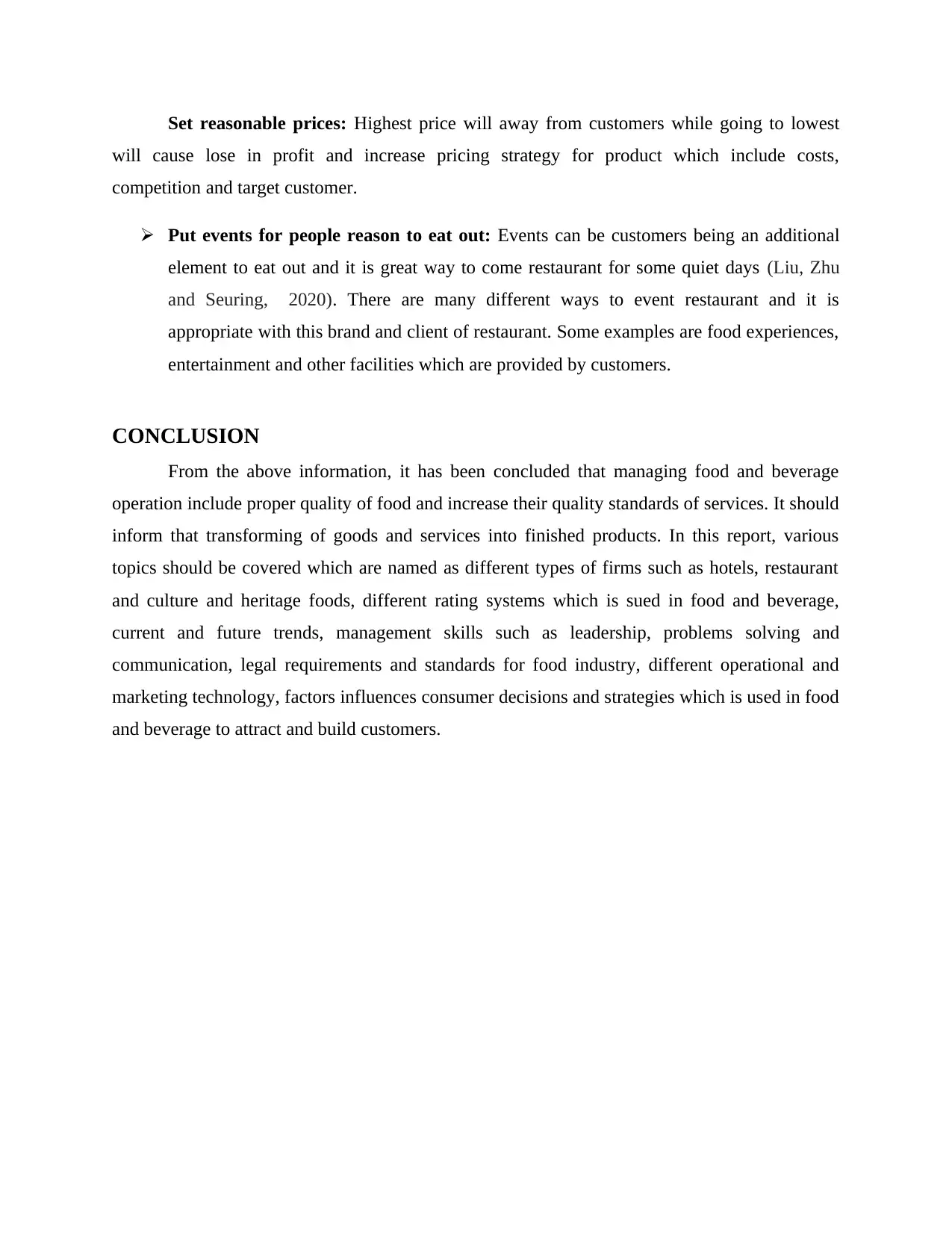
Set reasonable prices: Highest price will away from customers while going to lowest
will cause lose in profit and increase pricing strategy for product which include costs,
competition and target customer.
Put events for people reason to eat out: Events can be customers being an additional
element to eat out and it is great way to come restaurant for some quiet days (Liu, Zhu
and Seuring, 2020). There are many different ways to event restaurant and it is
appropriate with this brand and client of restaurant. Some examples are food experiences,
entertainment and other facilities which are provided by customers.
CONCLUSION
From the above information, it has been concluded that managing food and beverage
operation include proper quality of food and increase their quality standards of services. It should
inform that transforming of goods and services into finished products. In this report, various
topics should be covered which are named as different types of firms such as hotels, restaurant
and culture and heritage foods, different rating systems which is sued in food and beverage,
current and future trends, management skills such as leadership, problems solving and
communication, legal requirements and standards for food industry, different operational and
marketing technology, factors influences consumer decisions and strategies which is used in food
and beverage to attract and build customers.
will cause lose in profit and increase pricing strategy for product which include costs,
competition and target customer.
Put events for people reason to eat out: Events can be customers being an additional
element to eat out and it is great way to come restaurant for some quiet days (Liu, Zhu
and Seuring, 2020). There are many different ways to event restaurant and it is
appropriate with this brand and client of restaurant. Some examples are food experiences,
entertainment and other facilities which are provided by customers.
CONCLUSION
From the above information, it has been concluded that managing food and beverage
operation include proper quality of food and increase their quality standards of services. It should
inform that transforming of goods and services into finished products. In this report, various
topics should be covered which are named as different types of firms such as hotels, restaurant
and culture and heritage foods, different rating systems which is sued in food and beverage,
current and future trends, management skills such as leadership, problems solving and
communication, legal requirements and standards for food industry, different operational and
marketing technology, factors influences consumer decisions and strategies which is used in food
and beverage to attract and build customers.
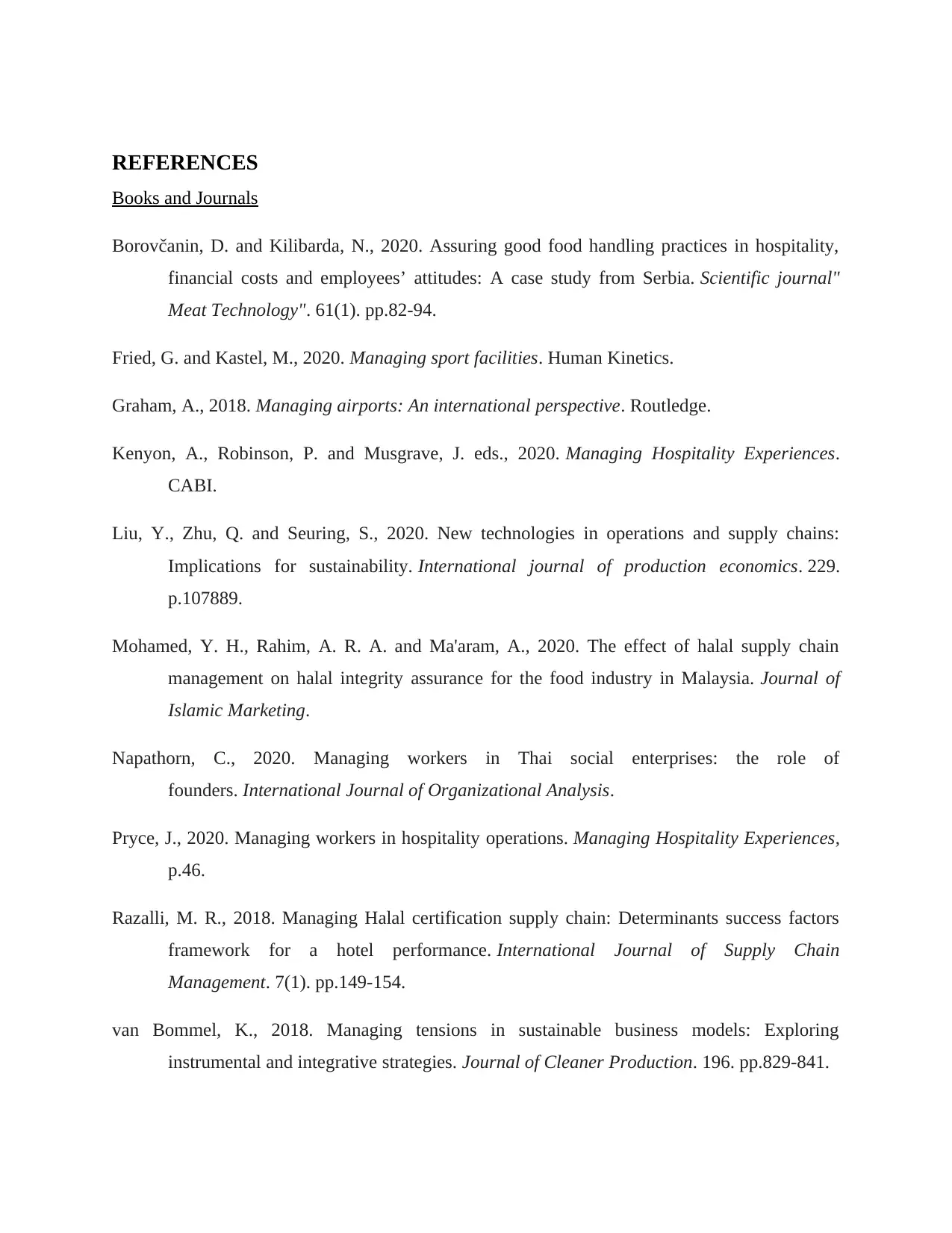
REFERENCES
Books and Journals
Borovčanin, D. and Kilibarda, N., 2020. Assuring good food handling practices in hospitality,
financial costs and employees’ attitudes: A case study from Serbia. Scientific journal"
Meat Technology". 61(1). pp.82-94.
Fried, G. and Kastel, M., 2020. Managing sport facilities. Human Kinetics.
Graham, A., 2018. Managing airports: An international perspective. Routledge.
Kenyon, A., Robinson, P. and Musgrave, J. eds., 2020. Managing Hospitality Experiences.
CABI.
Liu, Y., Zhu, Q. and Seuring, S., 2020. New technologies in operations and supply chains:
Implications for sustainability. International journal of production economics. 229.
p.107889.
Mohamed, Y. H., Rahim, A. R. A. and Ma'aram, A., 2020. The effect of halal supply chain
management on halal integrity assurance for the food industry in Malaysia. Journal of
Islamic Marketing.
Napathorn, C., 2020. Managing workers in Thai social enterprises: the role of
founders. International Journal of Organizational Analysis.
Pryce, J., 2020. Managing workers in hospitality operations. Managing Hospitality Experiences,
p.46.
Razalli, M. R., 2018. Managing Halal certification supply chain: Determinants success factors
framework for a hotel performance. International Journal of Supply Chain
Management. 7(1). pp.149-154.
van Bommel, K., 2018. Managing tensions in sustainable business models: Exploring
instrumental and integrative strategies. Journal of Cleaner Production. 196. pp.829-841.
Books and Journals
Borovčanin, D. and Kilibarda, N., 2020. Assuring good food handling practices in hospitality,
financial costs and employees’ attitudes: A case study from Serbia. Scientific journal"
Meat Technology". 61(1). pp.82-94.
Fried, G. and Kastel, M., 2020. Managing sport facilities. Human Kinetics.
Graham, A., 2018. Managing airports: An international perspective. Routledge.
Kenyon, A., Robinson, P. and Musgrave, J. eds., 2020. Managing Hospitality Experiences.
CABI.
Liu, Y., Zhu, Q. and Seuring, S., 2020. New technologies in operations and supply chains:
Implications for sustainability. International journal of production economics. 229.
p.107889.
Mohamed, Y. H., Rahim, A. R. A. and Ma'aram, A., 2020. The effect of halal supply chain
management on halal integrity assurance for the food industry in Malaysia. Journal of
Islamic Marketing.
Napathorn, C., 2020. Managing workers in Thai social enterprises: the role of
founders. International Journal of Organizational Analysis.
Pryce, J., 2020. Managing workers in hospitality operations. Managing Hospitality Experiences,
p.46.
Razalli, M. R., 2018. Managing Halal certification supply chain: Determinants success factors
framework for a hotel performance. International Journal of Supply Chain
Management. 7(1). pp.149-154.
van Bommel, K., 2018. Managing tensions in sustainable business models: Exploring
instrumental and integrative strategies. Journal of Cleaner Production. 196. pp.829-841.
⊘ This is a preview!⊘
Do you want full access?
Subscribe today to unlock all pages.

Trusted by 1+ million students worldwide
1 out of 13
Related Documents
Your All-in-One AI-Powered Toolkit for Academic Success.
+13062052269
info@desklib.com
Available 24*7 on WhatsApp / Email
![[object Object]](/_next/static/media/star-bottom.7253800d.svg)
Unlock your academic potential
Copyright © 2020–2025 A2Z Services. All Rights Reserved. Developed and managed by ZUCOL.





